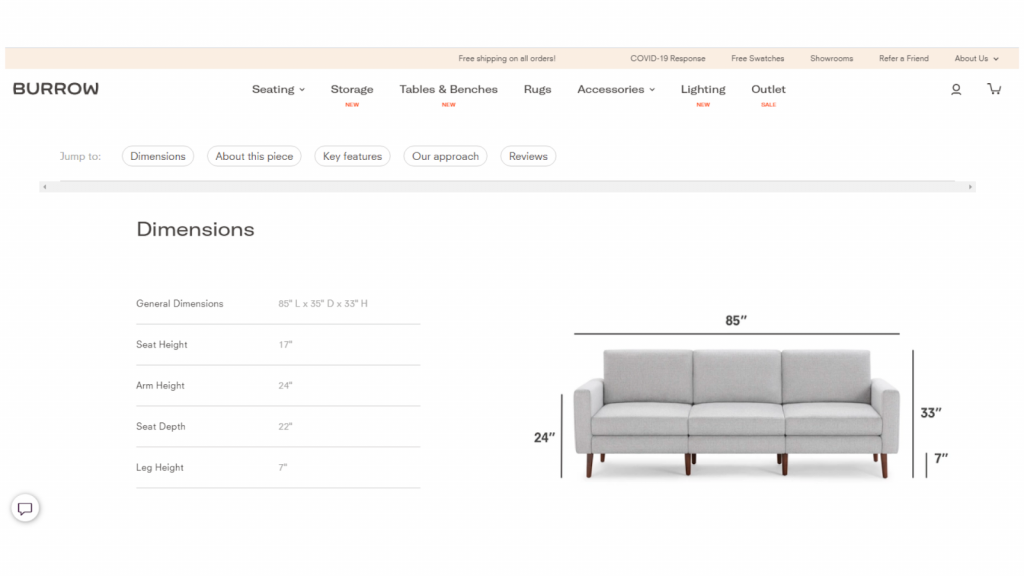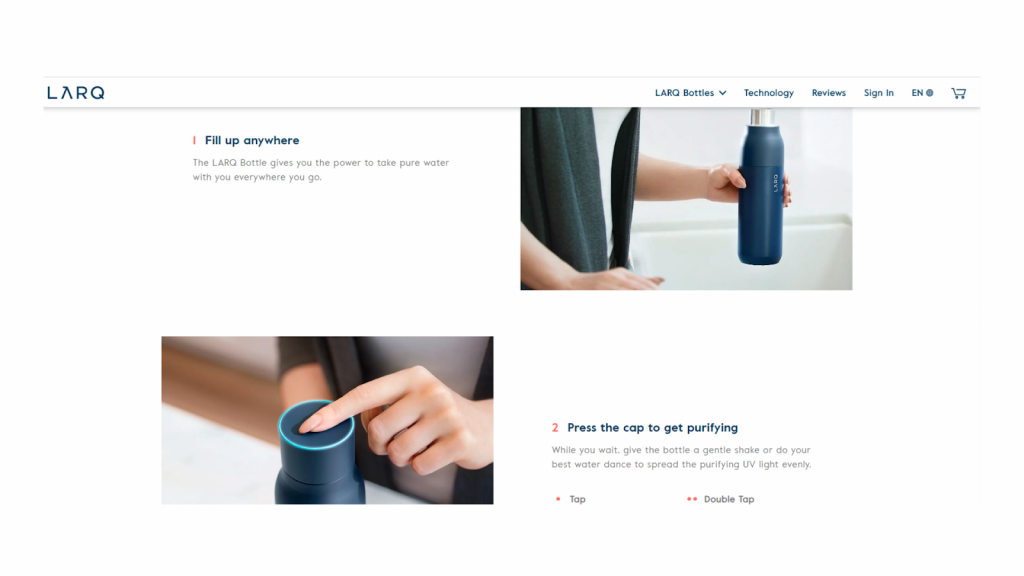
Writing product pages: essential do’s and don’ts for ecommerce brands
How would you rate your own product pages? Would you say that they were thoughtfully planned and the product descriptions – written to perfection? Or would you say they’re vague and only designed to make the visitor click as fast as possible?
The fact is that many online stores focus more on the website and overlook product pages. They rely on the home page, about page, brand story and other pretty parts of the site to convert the visitor so once they get to the product page they just add to cart.
Well-written product descriptions provide immense value for ecommerce businesses and they should never be ignored. According to Salsify, 94% of consumers will either abandon a site or give up if they can’t find the information they need to make a smart purchase decision.
Тhis article gives examples of good product page practices to help you write your own.
4 Reasons product pages are very important
Product pages in ecommerce are the dedicated places of each of your products. It is where they are showcased with all details and where the visitor should make the decision to buy. Here is why getting product pages right is essential.
1. Increase conversions
When product descriptions are carefully written out in detail shoppers are fully able to understand the value of your product. When shoppers are provided with all details they need to make an informed purchase, they convert more.
2. Help get organic traffic
Product pages have huge potential for bringing qualified traffic with high purchase intent. People naturally search for products and prices. If your product pages contain relevant keywords that potential customers would type in, you’ll rank high and people will find you easily.
3. Stand out from competitors
The product page is the best place to differentiate your brand from your competitors. While your home page can be vague and exciting, the product description should be detailed and precise.
It is where you explain how your products are better than the rest. All features, specifications, material information, patents and anything else special about your items should be on these pages.
4. Prevents exchanges and returns
Returns are costly for ecommerce brands and you don’t want the negative sentiment that they leave in the customer. Fortunately, a good share of returns and exchanges can be avoided thanks to well written product descriptions.
Related: Reducing returns when selling fashion online
When your descriptions are thorough and detailed, consumers know exactly what to expect from their purchase and chances are they will be satisfied with it. So, if you create clear, detailed product descriptions upfront you’re far less likely to deal with any of these hassles later on.
Do’s on product pages
So, what are the elements that make for a great product page?
1. Provide all details
When writing your product descriptions, keep in mind that the customer’s entire buying experience is done 100% online. They cannot touch or smell the product before they buying it.
That’s why you should provide them with as much information as possible to help them make an informed buying decision.
Related: Imitating the offline buying experience online
The online furniture brand Burrow does a great job at detailing their products. Because customers can’t try the furniture, Burrow uses the description to tell customers everything they need to know. They highlight essential info like the dimensions of the furniture to make sure customers choose right. The illustration makes it easy to understand what is what so no misunderstandings happen.
2. Talk about benefits
People care much more about the benefits your products give than the concrete features. They want to know how their problems will be solved – the baby will fall asleep faster, sweat will be wicked during workout, food will last longer in the fridge, etc.
Online brand Larq does this successfully by explaining how their water bottle purifies water and cleans itself on the go. Potential buyers quickly understand the main benefit and how the product fits their life.
3. Use sensory words
Sensory words are related to our five senses of hearing, smelling, seeing, tasting, and touching. Because customers can’t physically see, feel, or smell your product, the use of sensory words in your description will help enhance it in their minds and bring it to life.
Ethel’s Baking Company uses sensory words to describe their baked goods and it makes perfect sense. Their snickerdoodle cookies, for example, are described as being ‘soft baked and coated in cinnamon sugary goodness’. Reading a statement like this, shoppers can almost taste the cookies and the desire to buy grows immensely.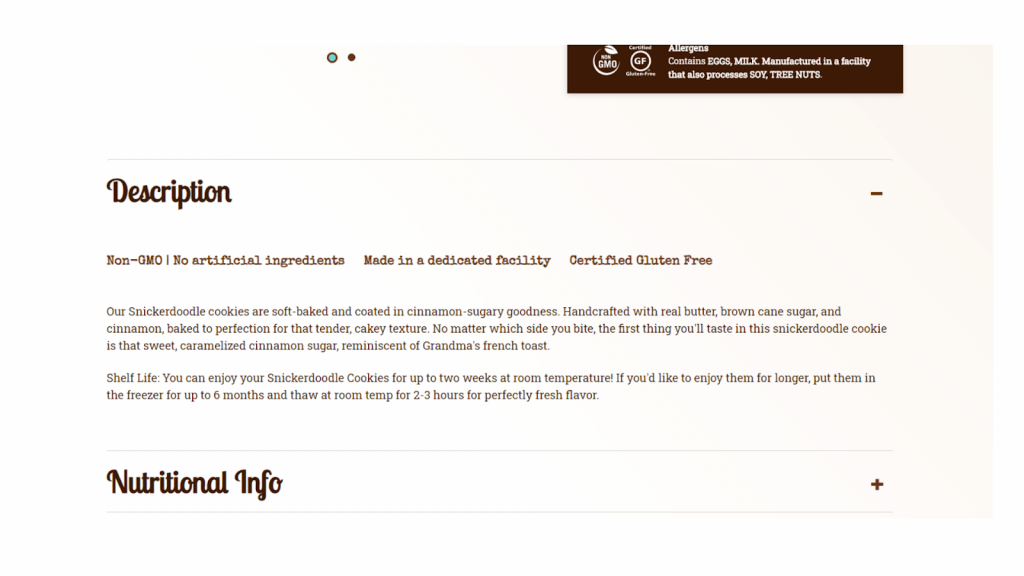
4. Use social proof
Customers want evidence that your product does what you say it does. They don’t want to be told – they want to see proof.
Testimonials and product reviews are the ultimate ways to prove your marketing claims. Including social proof on your product pages will help to influence the buying decision for future customers. Plus, they answer people’s questions in their own words.
Tommie Copper includes customer reviews on their product pages with satisfied customers talking about the product’s benefits. When hesitant customers see these reviews they are immediately put at ease and feel more comfortable making a buying decision.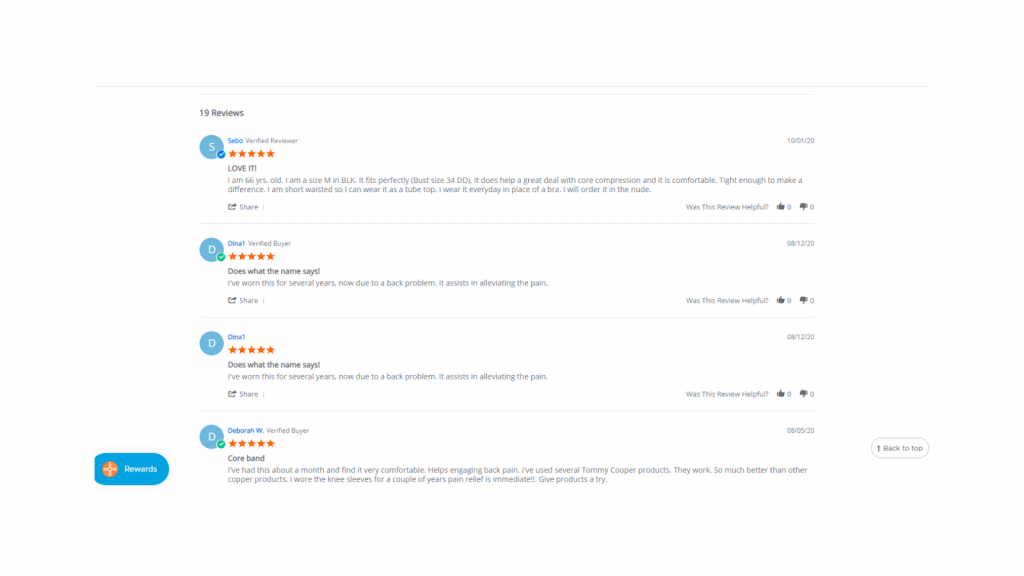
5. Make the description easy to read
Your product descriptions should be simple, clear, and easy to understand. The last thing you want is a description so complex that potential customers leave your site in despair.
When customers don’t understand your product description and offering, they’re far less likely to purchase your product.
This is what Clarks is trying to avoid in the descriptions of its shoes. One product is described as ‘feminine shoes that deliver a touch of luxury’. Instead of going with a more complex description, they’ve chosen to keep things clear and simple. That way, buyers know exactly what to expect from their purchase.
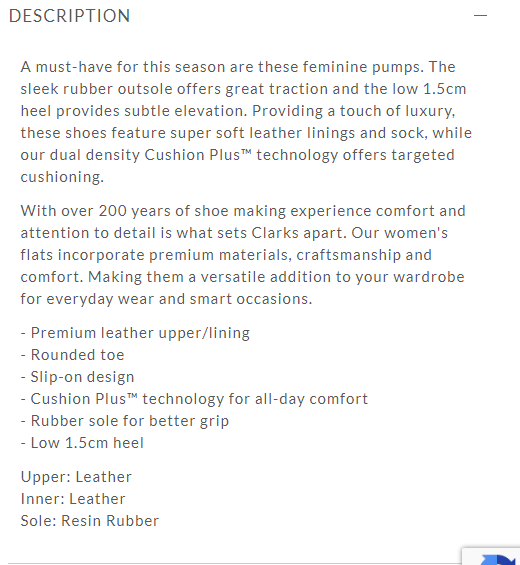
Don’ts of product pages
Now that we talked about what you should do, let’s discuss some of the things you shouldn’t do when writing your product descriptions.
1. Keep the manufacturer’s product description
[Disclaimer: this relates to dropshipping, if you manufacture your own products or order them to specifications to a factory and not buy them off a site, skip forward.] There are a couple of reasons why you should never keep the manufacturer’s description on your product page.
The first reason is because doing so won’t distinguish your brand from your competitors. If you sell products available from other retailers as well, your product pages should draw attention, make the product on your site better than the same thing everywhere else.
The second reason is that it won’t rank well in search results. When it comes to SEO, search engines favor original content over content that’s been copied multiple times across the web.
2. Make it too long
A product page that’s too long can bury important information. Shoppers might miss an important detail, especially if your formatting is just simple text without sections or at least bullets to make it all readable and skimmable.
Your description should be around 300 – 400 words. Divide it into sections so people find what they’re looking for easily – material, measurements, care, how it works, parts needed, etc. This will save you abandoned carts and lost sales.
3. Forget about your audience
Your product pages should focus on converting potential customers. This is another reason why copying the manufacturer’s description won’t work. It is usually very bland and generic while yours should be detailed and specific.
To effectively reach your audience you should consider your buyer persona in writing the description. Once you understand who your audience is, you will be able to write a description specifically for them that speaks their language.
4. Focus on features
We talked about the difference between features and benefits and why when writing product descriptions you should focus mostly on benefits. Customers care how your product will help them, save them time, or improve their lives.
We recommend talking about the benefits first, writing an inspiring story about the product in the life of the customer. Features can be listed in a separate subsection for those who want to see them.
Conclusion
Well-thought out product pages successfully sell products. We know there’s so much to think about when launching your brand but your products deserve proper display. If you need extra help, check out online courses on Udemy or Coursera, they offer ecommerce courses that can answer all of your questions!
This article has been contributed by Charlene Anderson, a researcher at BigCommerce where she thrives on uncovering strategies that help online businesses grow, improve, and succeed.
Build and grow your ecommerce brand
Metrilo’s mission is to help you build your ecommerce brand and win your place in the customer’s heart. We share what we learn from our daily work with product innovators and founders here. Subscribe to our weekly newsletter to get the freshest lessons and conquer your niche.
We promise, no spam.
Thank you for subscribing!
See you soon :-)
